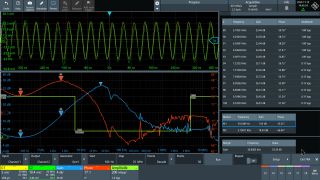Power supply rejection ratio measurement
With a Rohde & Schwarz oscilloscope

With a Rohde & Schwarz oscilloscope


The power supply rejection ratio or power supply ripple rejection (PSRR) must be measured when designing tate-of-the-art power supplies, including multiphase buck converters. The PSRR is important indication of power supply output stability and provides information about how input voltage variations influence output voltage stability.
Quick and easy analysis of low frequency response with an oscilloscope using the R&S®MXO-K36 frequency response analysis (Bode plot) option. Characterize the frequency response for a variety of electronics, including passive filters and amplifier circuits. Measure the control loop response and power supply rejection ratio for switchedmode power supplies. The R&S®MXO-K36 option uses the built-in waveform generator to create stimulus signals from 10 mHz to 100 MHz. By measuring the ratio of the stimulus signal to the DUT output signal at each test frequency, the oscilloscope logarithmically plots gain with phase linearity.
The R&S®MXO-K36 option lets you measure the power supply rejection ratio and characterize the transition from regulator system to regulated output.


Measurement setup for PSRR
The PSRR is analyzed by applying a sinusoidal ripple to the supply voltage and measuring the gain from regulator input to output as a ripple voltage frequency function.
A line injection transformer, such as Picotest J2120A, ensures the isolation of the injected signal and prevents induction of DC bias.


Using a ground spring will provide the best signal-to-noise ratio for your power supply rejection ratio measurement
Probing
Good probes are crucial to good PSRR measurements. The peak-to-peak Vout signal amplitude can be very small due to the high rejection ratio for the DC-to-DC converter under test. Probes with a higher dynamic range are needed.
Although most oscilloscopes usually have 10:1 passive probes, 1:1 passive probes on the output signal improve the dynamic range while significantly reducing intrinsic noise in the measuring system. Rohde & Schwarz recommends the R&S®RT-ZP1X 1:1 passive probes with 38 MHz bandwidth.
Reducing the length of a probe ground connection minimizes ground loop inductance. The standard probe ground lead can act as an antenna and amplify unwanted switching noise. If a ground post is near the Vin and Vout test points, do not use a long ground lead. Use the ground spring in the R&S®RT-ZP1X probe to shorten the ground connection for a good low-noise ground for the measurement.
Device setup
After connecting the oscilloscope to the circuit under test, the measurement is easy to start:


PSRR measurement using R&S®MXO-K36 frequency response analysis software option
Measurement results
The diagram shows the regulator system transition function for the applied ripple voltage as gain over frequency. Additional tools allow detailed PSRR analysis and movable markers at individual positions track the measured trace.
A table lists the marker coordinates.
The measurement results table contains detailed information about each measured point (frequency and gain). When using markers, the associated row of the result table is highlighted.
Oscilloscopes are the primary tools that engineers use for testing and characterizing power supply designs, such as multiphase buck converters. The R&S®MXO-K36 frequency response analysis (Bode plot) option is ideal for analyzing parameters such as the power supply rejection ratio.